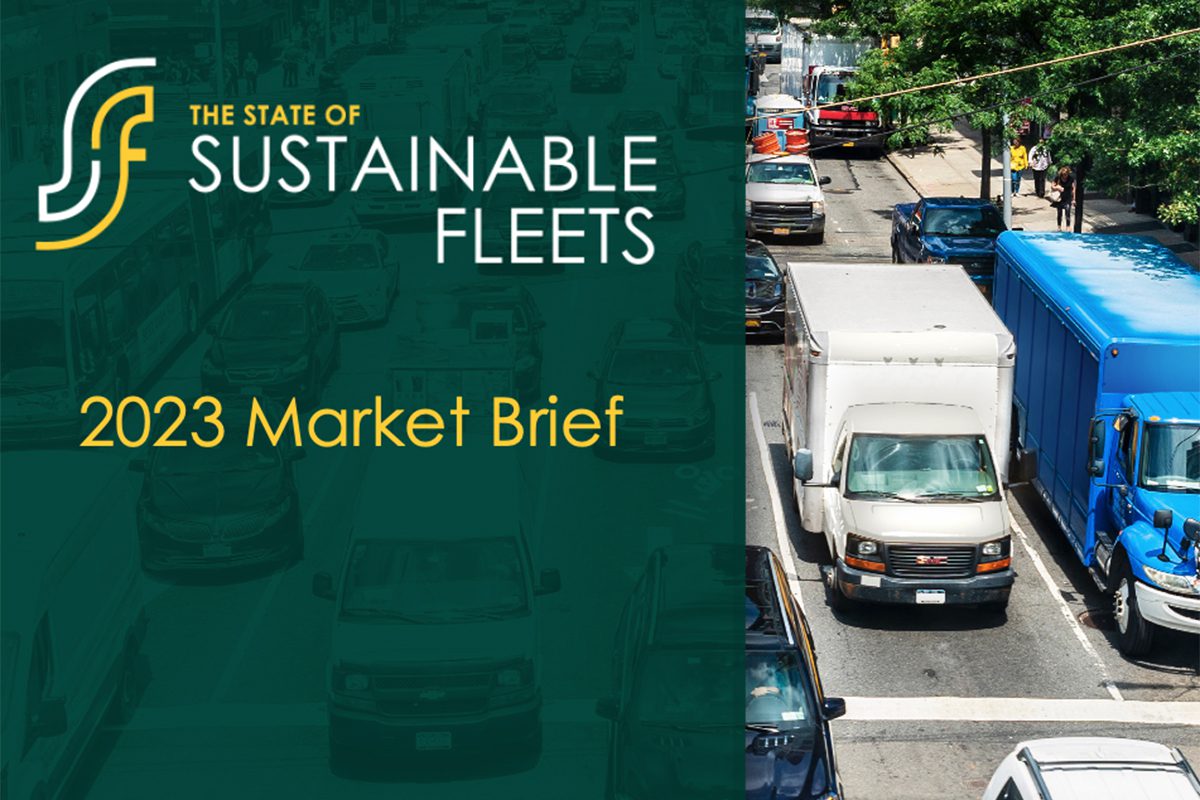In the fourth annual State of Sustainable Fleets Market Brief, a new trend is clear — public policy and funding has shifted sharply to build the ZEV market and sunset diesel engine development on an accelerated timeframe. Report author and leading clean technology consulting firm, Gladstein, Neandross & Associates (GNA), unveiled the findings at the Advanced Clean Transportation (ACT) Expo, a four-day conference which drew more than 10,000 attendees to Anaheim, California.
This year’s Market Brief illustrates much more about the future, one where new diesel engine development programs are moving towards a sunset, and zero-emission vehicles (ZEVs) will be the “law of the land” in states representing approximately half of the U.S. economy. The past 18 months have laid the roadmap for a zero-emission (ZE) future in many states and produced early signals that the era of the diesel engine, the workhorse of heavy-duty vehicles, will end sooner than many predicted. Previously, the State of Sustainable Fleets demonstrated that some clean fuels and vehicles are now superior to gasoline- and diesel-fueled vehicles for many fleet applications, and adoption of renewable fuels and advanced technology drivetrains is accelerating.
“The past year has brought a historic amount of investment from the federal government, as well as from private industry,” said Erik Neandross, CEO of GNA. “Across clean fuel types, we’re seeing accelerating momentum and an increasing commitment to low carbon fuels and zero emission commercial vehicles.”
This year’s report offers another deep analysis into the alternative fuels and clean transportation markets, with the following findings:
- The federal government and California have adopted rules requiring an 80% reduction in NOx emissions from diesel engines, adding tens of thousands of dollars to the cost of new diesel engines and likely requiring additional ongoing maintenance.
- More than $32 billion per year, on average, in public incentive funding for clean vehicles and infrastructure will be available for the next four to five years.
- A total of 13 states and the District of Columbia have passed or are considering some form of California’s ZEV sales mandate on manufacturers and these same states are expected to consider California’s ZEV purchase mandate on fleets that passed in late April.
- S. renewable diesel production doubled from 2021 – 2022 to 800 million gallons and renewable natural gas replaced nearly all fossil natural gas in California transportation for the second year in a row.
- In 2022, CNG averaged $2.73 per diesel-gallon-equivalent, and propane averaged $2.10 per-gasoline-gallon equivalent compared to an average of $5.78/gallon and $4.79/gallon for diesel and gasoline, respectively.
- Orders for medium- and heavy-duty battery-electric vehicles surged 640% with nearly 30,000 medium-duty orders and 2,400 heavy-duty battery-electric school bus orders in 2022.
- At least half of fleets across 11 different fleet types, including logistics, transit, school, cargo, and delivery fleets, have operated a medium- or heavy-duty battery-electric vehicle in the annual survey and 92% of those fleets plan to grow their use.
- Supply chain disruptions have raised the price of medium- and heavy-duty battery-electric vehicles and delays for electrical service have caused multi-year delays for some deployments.
- The public hydrogen station network grew 12% and the first plans to build station networksoutside of California were announced for the central, mid-Atlantic, and southwestern U.S.
Daimler Truck North America, Penske Transportation Solutions, and Shell serve as the title sponsors of this year’s Market Brief while Dana serves as supporting sponsor.
“Driving sustainability in North American transport, the State of Sustainable Fleets report brings together the most relevant data from key industry leaders and stakeholders and innovators,” said Thomas de Boer, CEO of Shell’s Commercial Road Transport business. “This forward-thinking report is a powerful tool that sparks engaging collaboration and helps commercial road transport decarbonize.”
“We appreciate the important work that GNA is doing to investigate trends in the zero-emission and alternative fuels space through the State of Sustainable Fleets Market Brief,” said Greg Treinen, vice president, on-highway market development, DTNA. “Their seminal study continues to show the important progress being made, and we look forward to working with our customers — the nation’s fleets — to assist in their transition to these propulsion technologies.”
“As detailed in this State of Sustainable Fleets report, progress is being made across all fronts,” explained Drew Cullen, Penske senior vice president of fuels and facility services. “ZEVs and other alternative powertrains, infrastructure, renewable energy, and funding all continue to make significant strides in meeting and exceeding fleet sustainability targets. This year’s report highlights the growing investments and innovations OEMs, energy providers, public and private fleets, and government agencies are making in developing, experimenting, and adopting clean transportation technologies.”
“The increasingly rapid shift to sustainable powertrains requires collaboration across the industry to help deliver continuous improvement for commercial vehicles for decades to come,” said Ryan Laskey, senior vice president of Dana Commercial Vehicle Drive and Motion Systems. “The State of Sustainable Fleets report enables us to gather and identify actionable data that we can use to support OEMs and fleets in delivering the best possible solutions to the market.”
The State of Sustainable Fleets is the leading source of information on sustainable technology decisions being made by America’s on-road fleets. The annual analysis gathers real-world data directly from early adopter fleets across the U.S. to provide deep sector-specific insights into the adoption of battery-electric, natural gas, propane, and hydrogen fuel cell electric vehicles, against a baseline of diesel and gasoline vehicles. The analysis provides insights into public, private, and for-hire fleets, including school bus, shuttle, state/county/municipal, urban delivery, refuse, utility, transit, regional-haul, long-haul, drayage, and off-road cargo handling sectors. This first-of-its-kind report, developed annually, includes unique insights into vehicle sale trends, anticipated vehicle development timelines, real-world infrastructure and fuel costs, and the growing adoption of renewable fuels.
To read the complete 2023 Market Brief, visit www.StateofSustainableFleets.com.


